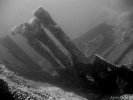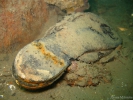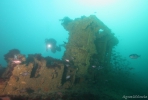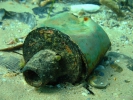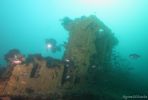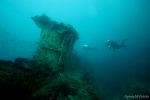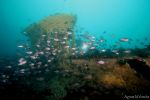|
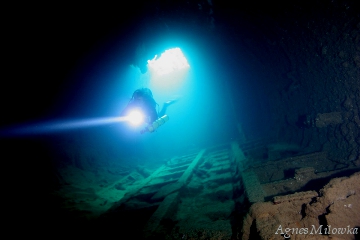
Long before the Australian Navy willingly bought reject submarines (read Collins-class) from the US, we were the bearer of refuse from the distinguished Royal Navy. They managed to discard not just one but the whole class of their dilapidated subs after WWI, thus all six of them got shipped over to Australia on the 15th of July 1919. (We could have got all seven but the J6 was sunk by friendly fire in 1918) After spending a whole heap of money on fixing them up the subs had a less then eventful life down South, little of which was actually spent at sea. By January 1924 they were all decommissioned through no fault of their own, as the defense budget was slashed and the funds to upkeep the beasts dried up. A couple of years later they were all happily resting on the bottom of the ocean.
To give credit where it’s due, the subs were built under pressing conditions i.e. war and rumors that the Germans already developed far superior subs. Not only do they have the distinction of being the only triple screw submarines ever built, they were also the fastest subs at the time plummeting along at 19 knots on the surface and up to 9.5 knots submerged. And heck, they did see some hot and heavy action during the war, even destroying a number of enemy ships like the Grosser Kurfurst and the Magdeburg.
This means that Victorian waters now hold our very own piece of WWI history and four of the subs have become exciting and awe inspiring playgrounds for divers. The other two subs aren’t diveable but are nevertheless interesting in the scheme of things.
J3 Sub
The J3 or the Swan Island sub used to be visited by divers, despite silty conditions and strong currents. Last time I tried to venture for a closer look a man in uniform with a rather large *gulp* megaphone was on the shore before we even geared up chewing our ear off. The sub is within the Prohibited Area of Swan Island (Department of Defense Facility) and is therefore for all intensive purposes out of bounds. Given the long military history around Swan Island, I guess there’s not much point arguing. You can however have a closer look at and even touch the bronze props of this sub, as they were removed and placed in a Queenscliff park, opposite the Maritime Museum.
J7
The J7 was sunk as a breakwater and is right in the middle of the Sandringham marina, which basically means it can’t be dived. Given that most of it is out of the water, you might as well head over for a sticky beak without the scuba gear and mesmerizing narcosis. It is actually fascinating to compare the sub to its underwater siblings, in terms of deterioration and size… yes, water does make things look bigger!
So this brings us to the four diveable subs the J1, J2, J4 and J5. They range from being easily accessible like the J4 to being downright impossible to get on, like the J2 or the ‘broken sub.’ (mind you this could be just me) The subs are awesome and they make for an amazing dive.
J4
Depth: 28m (92ft) max
The J4, commonly known as the ‘26m sub’ has got to be the most dived sub of them all and with good reason. It has a convenient depth, is easily accessible and is a bloody great dive.
It’s pretty much intact except for the bow which is broken off and exposes the torpedo tubes, while making a convenient entrance to the bowels of the sub. The bow and conning tower are the more interesting parts of the sub. There is a plaque on the conning tower dedicated to the divers who discovered it in 1982. There’s plenty of fish life around the top of the sub, including prolific schools of bullseyes and butterfly perch. There is a fair bit of growth on the hull, mostly kelp but also some colorful sponges. The stern is quite collapsed, virtually merging into the reef and is a tad boring really. The real fun however is inside it!
Inside the subs it is incredibly peaceful… there are streams of light bearing in through the cracks and holes. When the vis is good you can see straight through the sub - it’s magical. Being inside it gives you an amazing feeling and there’s lots of cool stuff to see. If you’re lucky you’ll see the resident blue devil fish. When the sun is down (or doesn’t bother getting up as is often the case around Melbourne) it gets quite dark down there, so a torch is a welcome addition to the kit.
As long as it’s not too surgy the 26m sub is readily penetrable. There are large openings all along it that can readily serve as an entry/exit point. If there is surge however, these openings can be dangerous as they can suck you in and then shove you up, washing machine style.
The only tighter section is around the stern… most of the time it’s pretty damn obvious when you shouldn’t be wedging yourself in there – as soon as you put your head near the hole to go in, it just about gets blown off by the surge!
The best part about the 26m sub is the depth and as a result the amount of time you can spend exploring. You can easily penetrate the length of the sub… and then some.
The sub got a fair beating during the wild storms in summer 2005 and there are some obvious changes. The bow area is all ripped up and bits of metal sheet are everywhere. Now that the ribs are exposed it actually makes it more photogenic, but it also means it’s more fragile than ever before so take care when diving it.
J5
Depth: 36m (119ft) max
The J5, or the ‘yellow submarine’ absolutely rocks! It’s yellow as its common name suggests, especially around the bow, stern and the conning tower… or another words, it is covered in yellow zoanthids. It is really, really pretty and the large schools of fish typically around the conning tower add to the breathtaking beauty. This is probably my favorite sub as the yellow zoanthids add something special. The stern of this sub is real nice too and worth checking out as you can still see the prop.
The 2005 storms played havoc with this sub also, and the bow section was ripped open. Yet, despite the damage it is still magical. The bow ring, which remains in place to this day, was the key to positively identifying it as the J5 sub. Each of the subs has a different and distinct bow ring and in 1993 a group of divers enthusiastic about the history of the submarines took the time to measure the J5 ring. They compared it to the historical records and as a result were able to positively confirm its identity.
J1
Depth: 38m (125ft) max
The J1, commonly referred to as the deep sub is also an unreal dive… again there is a lot of fish life up the top and around the conning tower and plenty to explore on the inside.
Again, this sub allows penetration by divers, and the hatch next to the conning tower is the way in. Off course, don’t go in unless you are sufficiently qualified and know what the heck you’re doing. The sub sits on an angle so it can be confusing if you silt the place up and are trying to get out. People have died here! The first ‘compartment’ is reasonably open and light still gets through, but towards the pointy ends of the sub it gets pretty dark, so a torch is no longer just a luxury but a necessary part of the kit.
The depth on this sub means that a thorough and slow look will usually put you into deco, so make sure you can deal with that.
J2
Depth: 41m (135ft) max
Well this is one of those subs that keep on getting away… at least from me. The sub was scuttled close to the ‘Heads’, the narrow and treacherous entrance to Port Phillip Bay and is therefore close to the shipping channel and also arguably in the line of fire when it comes to the tides. The strong tides and currents in the area surrounding the Heads mean that it should only be dived close to slack water. The alignment of tides and no shipping has not been in my favor, so I am yet to see this sub with my own eyes.
|



